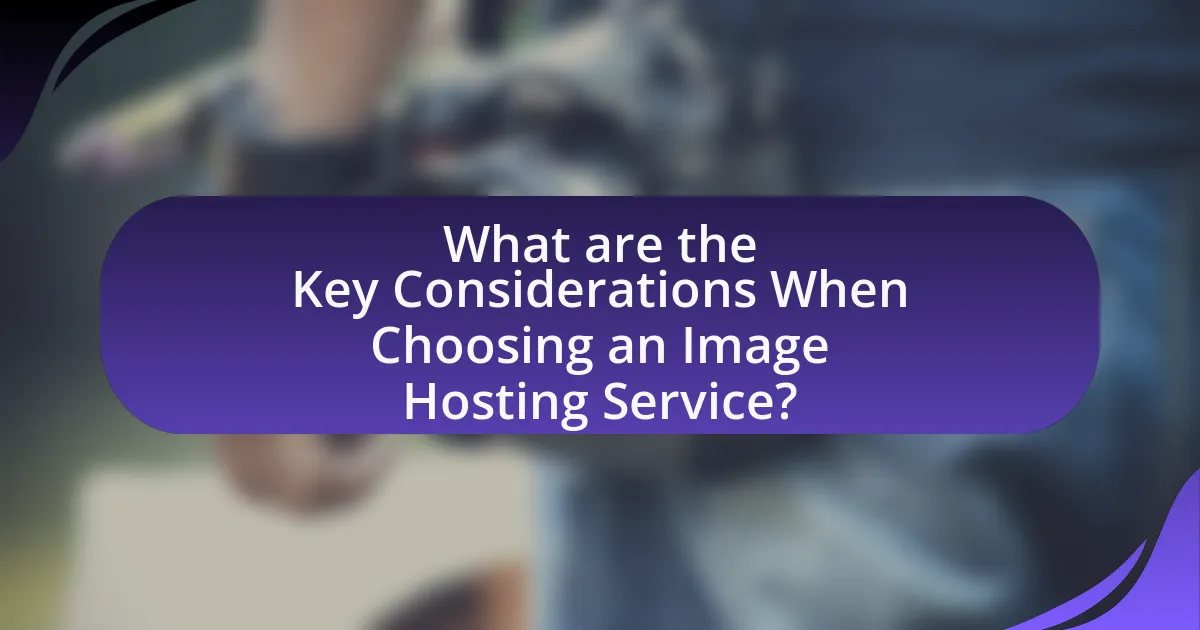The article focuses on comparing the best image hosting services for photographers, highlighting key platforms such as SmugMug, Flickr, and 500px. It examines how these services cater to photographers’ needs through features like customizable galleries, unlimited storage, and community engagement. The article also discusses essential factors to consider when choosing an image hosting service, including storage limits, pricing models, security features, and the impact of these services on photographers’ workflows and online presence. Additionally, it addresses user experiences, common issues faced, and tips for maximizing the benefits of image hosting services.
What are the Best Image Hosting Services for Photographers?

The best image hosting services for photographers include SmugMug, Flickr, and 500px. SmugMug offers customizable galleries and unlimited storage, making it ideal for professional photographers. Flickr provides a large community and social features, allowing photographers to share and discover images easily. 500px focuses on high-quality photography and offers a platform for showcasing work and gaining exposure. Each of these services has unique features that cater to the specific needs of photographers, such as storage capacity, community engagement, and presentation options.
How do different image hosting services cater to photographers’ needs?
Different image hosting services cater to photographers’ needs by offering specialized features such as high-resolution storage, customizable galleries, and robust sharing options. For instance, services like SmugMug provide unlimited storage and customizable portfolio websites, allowing photographers to showcase their work professionally. Meanwhile, platforms like Flickr focus on community engagement, offering social networking features that enable photographers to connect and receive feedback. Additionally, services such as 500px emphasize licensing and selling images, providing photographers with opportunities to monetize their work. These tailored features address the diverse requirements of photographers, from storage and presentation to marketing and sales.
What features should photographers look for in an image hosting service?
Photographers should look for features such as high-resolution image storage, customizable galleries, and robust security options in an image hosting service. High-resolution storage ensures that images maintain quality for professional use, while customizable galleries allow photographers to showcase their work in a personalized manner. Robust security options, including encryption and backup solutions, protect valuable images from unauthorized access and data loss. These features are essential for maintaining the integrity and presentation of a photographer’s portfolio.
How do storage limits impact photographers’ choices?
Storage limits significantly influence photographers’ choices by dictating the volume and quality of images they can store and manage. Photographers often select image hosting services based on their storage capacity, as limited storage can restrict the number of high-resolution images they can upload, impacting their workflow and project completion. For instance, a photographer with a storage limit of 100 GB may need to prioritize which images to keep, potentially leading to the loss of valuable work. Additionally, services with higher storage limits often come with better organizational tools and features, which can enhance a photographer’s efficiency and ease of access to their portfolio.
What are the pricing models of popular image hosting services?
Popular image hosting services typically utilize subscription-based pricing models, offering various tiers based on storage capacity and features. For instance, services like SmugMug provide plans ranging from $7 to $42 per month, depending on the level of customization and storage needed. Similarly, Flickr offers a free tier with limited storage and a Pro subscription at approximately $6 per month, which includes additional features like advanced statistics and ad-free browsing. Google Photos operates on a freemium model, allowing users to store photos for free up to a certain limit, with paid plans starting at $1.99 per month for additional storage. These pricing structures cater to different user needs, from casual photographers to professionals requiring extensive storage and advanced features.
How do subscription plans vary among different services?
Subscription plans vary significantly among different image hosting services for photographers, with options typically including free tiers, monthly or annual paid plans, and specialized packages. For instance, services like SmugMug offer tiered pricing based on storage capacity and features, ranging from basic plans at approximately $7 per month to advanced plans exceeding $40 per month, which include additional features like custom domains and e-commerce capabilities. In contrast, platforms like Flickr provide a free option with limited storage and a Pro plan at around $6 per month, which offers unlimited storage and advanced statistics. This variation allows photographers to choose plans that best fit their needs, whether they prioritize cost, storage, or specific functionalities.
What are the pros and cons of free versus paid image hosting services?
Free image hosting services offer no cost, making them accessible for users with limited budgets, but they often come with limitations such as lower storage capacity, potential for ads, and less reliable uptime. In contrast, paid image hosting services provide enhanced features like increased storage, better security, and customer support, but they require a financial investment. For example, a study by HostingAdvice in 2021 indicated that paid services typically offer 99.9% uptime compared to around 95% for free services, highlighting the reliability advantage of paid options.
How do Image Hosting Services Enhance Photographers’ Workflows?

Image hosting services enhance photographers’ workflows by providing efficient storage, organization, and sharing capabilities for their images. These services allow photographers to upload large volumes of high-resolution images, which can be accessed from any device, streamlining the process of managing their portfolios. Additionally, many image hosting platforms offer features such as tagging, categorization, and search functionality, enabling photographers to quickly locate specific images.
Moreover, these services often include options for client galleries, allowing photographers to share proofs and final images with clients easily, which can expedite the approval process. According to a survey by the Professional Photographers of America, 70% of photographers reported that using image hosting services improved their client communication and overall efficiency. This demonstrates that image hosting services play a crucial role in optimizing the workflow of photographers by enhancing accessibility, organization, and client interaction.
What role does image hosting play in a photographer’s online presence?
Image hosting is crucial for a photographer’s online presence as it provides a platform to showcase and share their work effectively. By utilizing image hosting services, photographers can ensure high-quality images are displayed, which enhances their portfolio’s visual appeal and accessibility. Additionally, these services often offer features such as customizable galleries, SEO optimization, and social media integration, which can significantly increase visibility and engagement with potential clients. For instance, a study by the Content Marketing Institute found that visual content is 40 times more likely to be shared on social media, underscoring the importance of image hosting in reaching a broader audience.
How can image hosting services improve website loading times?
Image hosting services can improve website loading times by optimizing image delivery through techniques such as compression, content delivery networks (CDNs), and lazy loading. These services reduce the file size of images without significantly sacrificing quality, which decreases the amount of data that needs to be transferred when a user accesses a website. For instance, using a CDN allows images to be served from a location closer to the user, minimizing latency and speeding up load times. Additionally, lazy loading ensures that images are only loaded when they are about to enter the viewport, which further enhances performance by reducing initial load time and conserving bandwidth.
What are the SEO benefits of using image hosting services?
Using image hosting services enhances SEO by improving website loading speed, which is a critical ranking factor for search engines. Faster loading times lead to better user experience and lower bounce rates, both of which positively influence search engine rankings. Additionally, image hosting services often provide optimized images, reducing file sizes without sacrificing quality, further contributing to improved site performance. Furthermore, these services typically offer features like alt text management, which helps search engines understand the content of images, thereby enhancing visibility in image search results. Overall, leveraging image hosting services can lead to higher search engine rankings and increased organic traffic.
How do image hosting services facilitate client interactions?
Image hosting services facilitate client interactions by providing platforms for easy sharing, viewing, and commenting on images. These services enable photographers to create galleries that clients can access, allowing for streamlined communication regarding preferences and feedback. Features such as direct links, embedding options, and social sharing capabilities enhance the interaction by making it simple for clients to view and share images with others. Additionally, many image hosting services offer tools for client proofing and selection, which further simplifies the decision-making process for clients.
What tools do these services provide for sharing and collaboration?
Image hosting services provide various tools for sharing and collaboration, including direct image links, social media integration, and collaborative albums. These features enable photographers to easily share their work with clients and peers, facilitating feedback and joint projects. For instance, platforms like Flickr and SmugMug allow users to create shared galleries where multiple contributors can upload and manage images, enhancing collaborative efforts. Additionally, many services offer commenting systems and tagging options, which further streamline communication and organization among users.
How can photographers use image hosting for client proofing?
Photographers can use image hosting for client proofing by uploading their images to a secure online platform where clients can view, select, and provide feedback on the photos. This method streamlines the proofing process, allowing clients to easily access their images from any device, facilitating quicker decisions and enhancing communication. Image hosting services often include features such as password protection, customizable galleries, and the ability to leave comments or ratings, which further improve the client experience and ensure that photographers can efficiently manage their workflow.
What are the Key Considerations When Choosing an Image Hosting Service?

When choosing an image hosting service, key considerations include storage capacity, ease of use, cost, security features, and integration options. Storage capacity is crucial as it determines how many images can be uploaded; for example, services like Google Photos offer substantial free storage, while others may charge for additional space. Ease of use affects how quickly users can upload and manage their images; platforms with intuitive interfaces, such as SmugMug, enhance user experience. Cost is a significant factor, as pricing models vary widely, with some services offering free tiers and others requiring subscriptions. Security features, including encryption and backup options, are essential to protect images from unauthorized access or loss; services like Flickr provide robust security measures. Lastly, integration options with other tools and platforms can streamline workflows for photographers, making services that offer API access or plugins, like Adobe Lightroom integration with various hosting services, particularly appealing.
How do security features vary among image hosting services?
Security features among image hosting services vary significantly in terms of encryption, access controls, and data backup protocols. For instance, some services offer end-to-end encryption, ensuring that images are secure during upload and storage, while others may only provide basic HTTPS encryption. Access controls also differ; certain platforms allow users to set permissions for who can view or download images, whereas others may have more open access settings. Additionally, data backup protocols can range from automatic backups to user-initiated backups, impacting the reliability of data recovery in case of loss. These variations highlight the importance of evaluating security features based on individual needs and the sensitivity of the images being hosted.
What measures do hosting services take to protect photographers’ work?
Hosting services implement several measures to protect photographers’ work, including watermarking, copyright management tools, and secure storage solutions. Watermarking helps deter unauthorized use by overlaying a logo or text on images, making them less appealing for theft. Copyright management tools allow photographers to register their images and monitor usage, providing legal recourse against infringement. Additionally, secure storage solutions, such as encrypted servers and regular backups, safeguard images from data loss and unauthorized access, ensuring that photographers’ work remains protected.
How important is data backup and recovery in image hosting?
Data backup and recovery are crucial in image hosting because they ensure the preservation of valuable visual content against data loss. Image hosting services frequently store large volumes of user-generated content, making them susceptible to risks such as server failures, cyberattacks, or accidental deletions. According to a study by the Ponemon Institute, 60% of small businesses that experience data loss close within six months, highlighting the critical need for reliable backup solutions. Effective data recovery processes enable photographers to restore their images quickly, minimizing downtime and potential financial losses.
What are the user experiences with popular image hosting services?
User experiences with popular image hosting services vary significantly, often influenced by factors such as ease of use, storage capacity, and customer support. For instance, users frequently report that services like Flickr and Google Photos offer intuitive interfaces and robust organizational features, making it easy to upload and categorize images. In contrast, platforms like Imgur are praised for their simplicity and speed, particularly for sharing images quickly on social media.
Moreover, many users express concerns regarding the limitations on storage and image quality on free tiers of services, with some noting that paid options, such as SmugMug, provide enhanced features and better customer support. According to a survey conducted by TechRadar, 65% of users prefer platforms that offer seamless integration with other tools and social media, highlighting the importance of connectivity in user satisfaction. Overall, user experiences reflect a balance between functionality, accessibility, and support across different image hosting services.
How do customer reviews influence the choice of image hosting service?
Customer reviews significantly influence the choice of image hosting service by providing potential users with insights into the experiences of existing customers. These reviews often highlight key factors such as reliability, ease of use, customer support, and features offered by the service. For instance, a study by BrightLocal found that 91% of consumers read online reviews regularly, and 84% trust them as much as personal recommendations. This indicates that positive reviews can enhance a service’s credibility, while negative reviews can deter potential users, ultimately shaping their decision-making process.
What common issues do photographers face with image hosting services?
Photographers commonly face issues such as limited storage capacity, slow upload and download speeds, and inadequate customer support with image hosting services. Limited storage can restrict the number of images a photographer can store, impacting their workflow and accessibility. Slow speeds hinder the efficiency of sharing and accessing images, which is crucial for timely client interactions. Inadequate customer support can lead to unresolved technical problems, further complicating the photographer’s ability to manage their portfolio effectively. These challenges can significantly affect a photographer’s productivity and client satisfaction.
What tips can photographers follow to maximize their image hosting experience?
Photographers can maximize their image hosting experience by selecting a platform that offers high-resolution image support, user-friendly interfaces, and robust sharing options. Choosing a service that allows for easy organization of images through albums or tags enhances accessibility and retrieval. Additionally, utilizing platforms with strong security measures ensures the protection of intellectual property. Photographers should also consider services that provide analytics to track viewer engagement, as this data can inform future work and marketing strategies. Finally, leveraging cloud storage options for backup can safeguard against data loss, ensuring that images remain accessible and secure.



